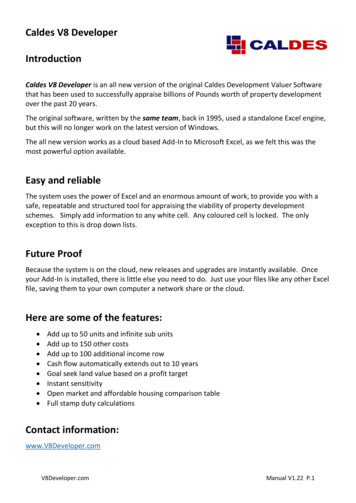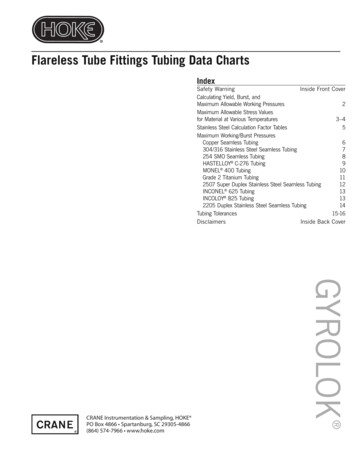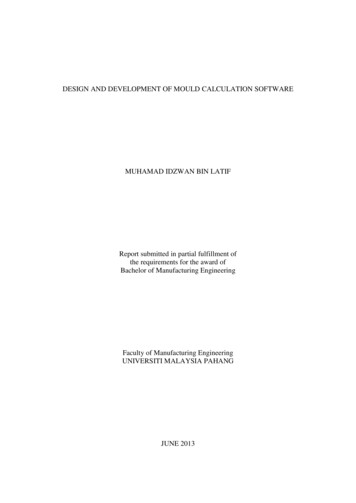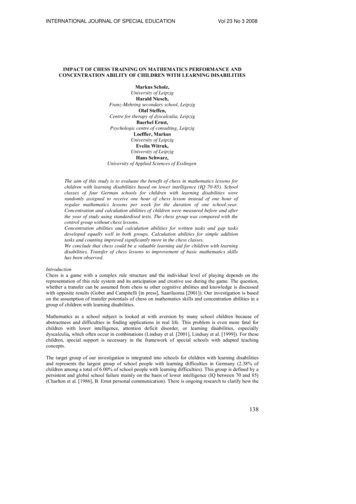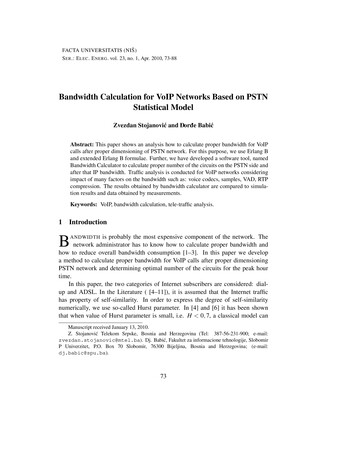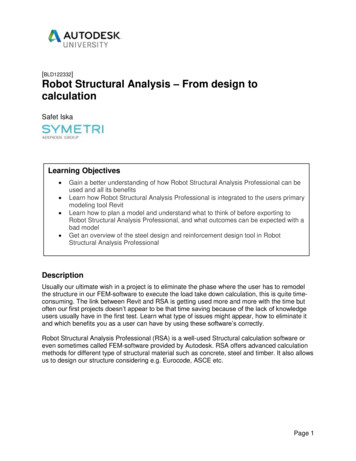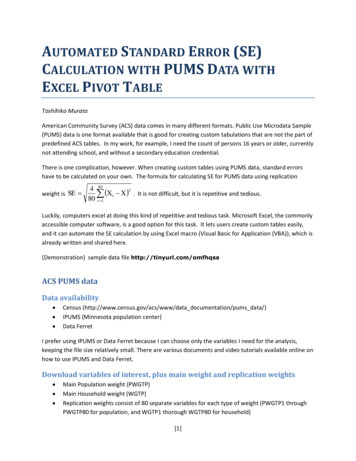
Transcription
AUTOMATED STANDARD ERROR (SE)CALCULATION WITH PUMS DATA WITHEXCEL PIVOT TABLEToshihiko MurataAmerican Community Survey (ACS) data comes in many different formats. Public Use Microdata Sample(PUMS) data is one format available that is good for creating custom tabulations that are not the part ofpredefined ACS tables. In my work, for example, I need the count of persons 16 years or older, currentlynot attending school, and without a secondary education credential.There is one complication, however. When creating custom tables using PUMS data, standard errorshave to be calculated on your own. The formula for calculating SE for PUMS data using replicationweight is SE 4 80 X r X 2 . It is not difficult, but it is repetitive and tedious. 80 r 1Luckily, computers excel at doing this kind of repetitive and tedious task. Microsoft Excel, the commonlyaccessible computer software, is a good option for this task. It lets users create custom tables easily,and it can automate the SE calculation by using Excel macro (Visual Basic for Application (VBA)), which isalready written and shared here.{Demonstration} sample data file http://tinyurl.com/omfhqsaACS PUMS dataData availability Census (http://www.census.gov/acs/www/data documentation/pums data/)IPUMS (Minnesota population center)Data FerretI prefer using IPUMS or Data Ferret because I can choose only the variables I need for the analysis,keeping the file size relatively small. There are various documents and video tutorials available online onhow to use IPUMS and Data Ferret.Download variables of interest, plus main weight and replication weights Main Population weight (PWGTP)Main Household weight (WGTP)Replication weights consist of 80 separate variables for each type of weight (PWGTP1 throughPWGTP80 for population, and WGTP1 thorough WGTP80 for household)[1]
File size can easily become very large because you need to get 81 variables for weights alone. Ananswer to “How big is too large for Excel Pivot table?” depends largely on the available memory of thecomputer used in the analysis. My work computer with 16GB of installed memory starts to complainwith a database containing 100 variables and 1.7 million rows. The dataset, 2013 ACS 1Year Estimate forthe entire U.S. population has a little over 3 million rows of records. This is too big to use in a raw dataformat. So if I need to use an entire file, I need some kind of work around.Building the Pivot TableThe first step is building a pivot table with the downloaded data. Select the “insert” tab from the ribbon,then click on the pivot table button to start the pivot table dialog. If you have the data file open, thatdata will be selected as the default. Pivot tables also work with external formats such as MS Access MSSQL Server tables.Once data is selected, click OK. The rest is simple --drag and drop variables into columns, rows andreport filter areas of the pivot table--process. PUMS data is weighted (each case represents multiplecases), “values “or “pivot table data field” must be set to sum of main weight variable (PWGTP forpopulation, WGTP for households).[2]
Visual Basic Code for Calculating Standard ErrorsVisual Basic for Application (VBA) for ExcelExcel Visual Basic for Application is an application development environment that is particularly suitedfor data and statistical work. It is full of useful data and statistics-related “objects” in this objectoriented programming environment. For example, “Pivot table” is one of the Excel objects and is usedhere. This object is already fully developed and defined, so by using code, we are making this object douseful things and capturing the results.Interaction with VBA code takes place in a separate “Visual Basic for Application” window. The easiestway to get this window is from the ribbon. The buttons to start this window is hidden by the default. Toshow this button, use” Customize the ribbon” dialog, and check the “developer” option. This will add the“developer” tab on ribbon.Locations to Store Visual Basic CodesThe VBA Codes can be saved in an individual workbook, or in the default VBA code storage called“Personal Macro Workbook (personal.xlsb)”. One advantage of storing codes here is that once thisworkbook is created, codes in this workbook are always available anytime you start Excel.[3]
The easiest way to create this workbook is by “record a macro”. When a macro is recorded and saved,Excel will create and save the personal macro workbook with the proper name and the location( C:\Users\ username xlsb).To record a macro, go to the developer tab on the ribbon, and click the record macro button (see below).In the record macro dialog box, select personal macro workbook option from the dropdown list, andclick OK. Then do something (like selecting a different cell). Click onto stop. Open VBAwindow by clicking the “Visual Basic” button on the “Developer” tab. The code just created fromrecoding is saved under VBA Projects (“prosonal.xlsb”), Modules – Module 1, sub Macro1().[4]
ACS se.txtTo use the standard error calculation code or sub procedure (Sub get se()) , simply copy andpaste the code into the modules window, below the End Sub statement. Each VBA sub procedure ismarked by Sub and End Sub pair.To run this code, chose “Run” from the menu or click the “Run” buttonon the tool bar while in VBAproject editor window, while you have the pivot table open in the main Excel window. The code can bealso run on the quick access tool bar, or the ribbon by assigning the code to button that you create.Detailed Look at the VBA codeOpen the attached Word document for detailed explanations.Microsoft WordDocumentImportance of Checking SE When Using PUMS dataWith Excel, it is very easy to drill down to finer and finer subgroups. It is important to keep in mind thatSE becomes larger as the grouping becomes finer. Because of this, checking SE frequently along the wayis very important.{Demonstration – add sex, race and puma sequentially and show what happens to SE}{Demonstration – back out, use grouping to reduce SE}ExerciseCreate a Procedure that Calculates Household SE Copy and paste the sub procedure, get se(), into the same module.Rename the sub procedure to get se hh (or something logical).Replace PWGTP with WGTP (see highlighted area in the annotated code)Optional: rename variables in the code where appropriateOriginal Word Document and sample data at http://tinyurl.com/omfhqsa[5]
( C:\Users\ username xlsb). To record a macro, go to the developer tab on the ribbon, and click the record macro button (see below). In the record macro dialog box, select personal macro workbook option from the dropdown list, and click OK. Then do something (like selecting a different cell).



